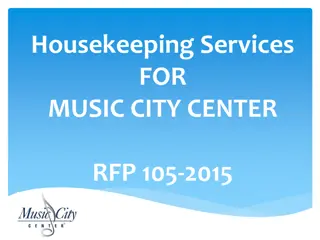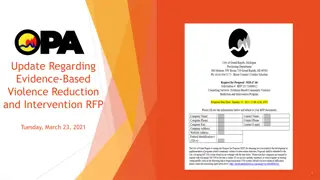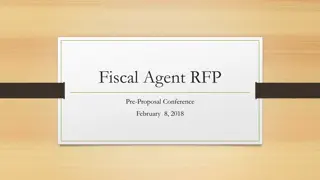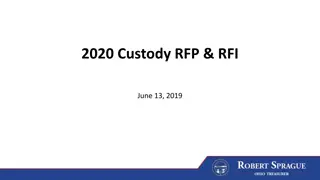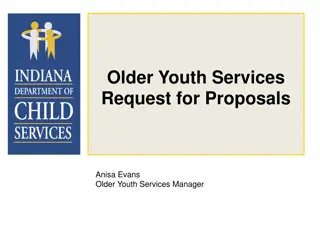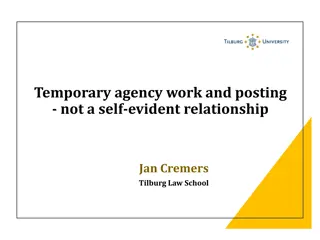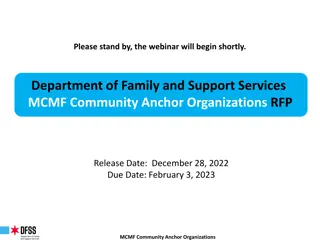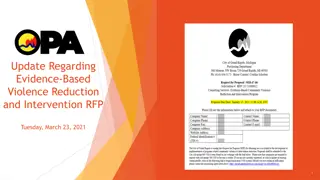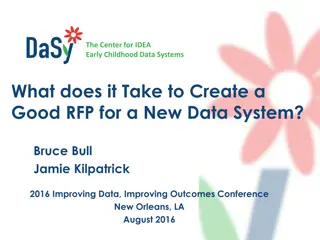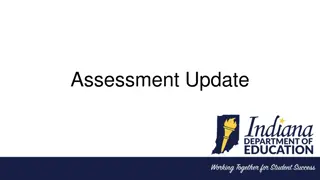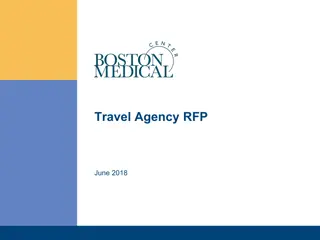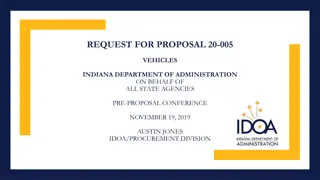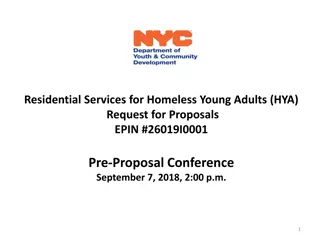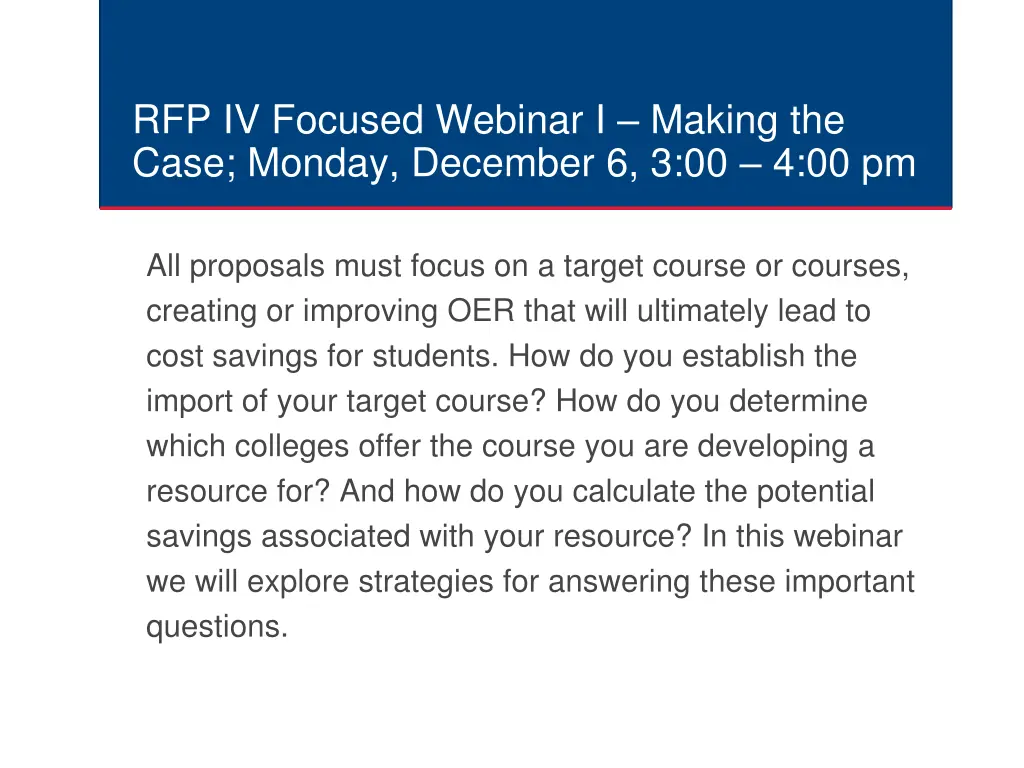
Strategies for Developing Cost-Saving OER in Higher Education
Explore the importance of establishing target courses, finding colleges offering them, and calculating potential savings in creating or enhancing OER to reduce student costs. Learn from experts in a focused webinar session.
Download Presentation

Please find below an Image/Link to download the presentation.
The content on the website is provided AS IS for your information and personal use only. It may not be sold, licensed, or shared on other websites without obtaining consent from the author. If you encounter any issues during the download, it is possible that the publisher has removed the file from their server.
You are allowed to download the files provided on this website for personal or commercial use, subject to the condition that they are used lawfully. All files are the property of their respective owners.
The content on the website is provided AS IS for your information and personal use only. It may not be sold, licensed, or shared on other websites without obtaining consent from the author.
E N D
Presentation Transcript
RFP IV Focused Webinar I Making the Case; Monday, December 6, 3:00 4:00 pm All proposals must focus on a target course or courses, creating or improving OER that will ultimately lead to cost savings for students. How do you establish the import of your target course? How do you determine which colleges offer the course you are developing a resource for? And how do you calculate the potential savings associated with your resource? In this webinar we will explore strategies for answering these important questions.
Overview Target course(s), creating or improving Establishing the importance of your target programs, colleges, etc. Calculating potential savings Questions and Answers Photo by Konstantin Evdokimov on Unsplash 2
Your Presenters and Chat Managers Dave Dillon Regional Lead, ASCCC OERI Counseling Faculty, Grossmont College Shagun Kaur Project Facilitator, ASCCC OERI Communication Studies Faculty, De Anza College Michelle Pilati Faculty Coordinator, ASCCC OERI Psychology Faculty, Rio Hondo College 3
Target Course(s) Section B. Project Description B.1 - Overview and Need. Please provide a description of the proposal. Briefly describe your project complete details are to be provided when delineating your deliverables. Be sure to identify the target course or courses that your project is intended to support. Explain why the proposed resource is needed. Provide data as appropriate. If the resource is a revision to or an ancillary for an existing OER text-equivalent, be sure to identify the existing text-equivalent.
Section A. Proposal Overview 5. Statewide Course Category Courses specified by C-ID or title in a Transfer Model Curriculum (TMC) or Model Curriculum. Required courses in career technical education (CTE) programs. Courses that fulfill the recently implemented ethnic studies general education requirement (i.e., CSU GE Area F) and related majors. Commonly-taught general education courses. Non-CTE courses that are commonly required in degrees for which there is no TMC. Other courses that address a statewide need.
Transfer Model Curriculum (TMC) or Model Curriculum (MC) C-ID.net What is a TMC or MC? A framework for a degree or certificate. TMCs provide the framework for Associate Degrees for Transfer (AA-T or AS-T) MCs provide a framework for degrees that don t quite meet the TMC requirements or for CTE certificates A valued course category as required courses are likely to meet statewide needs
Why C-ID? Why Model Curriculum At the course level, C-ID establishes what a given course must have to be recognized as that course every college s local course may be a little different C-ID establishes what all those different courses need to have to be viewed as comparable. Similarly, model curriculum do that same at the certificate or degree level. TMC-aligned degrees are always required legally mandated if you have a degree in the TOP Code of the TMC.
EDUC 200 Required in the Elementary Education TMC MAY be no resources EDUC 200 refers to a C-ID descriptor simplifying determining how many colleges have the course Any college that has an Elementary Education ADT must have such a course How do you determine which colleges have a course aligned to a particular C-ID descriptor?
Required courses in career technical education (CTE) programs. Challenging is there a statewide model that can be referred to? Existing Model Curriculum Very limited. Addiction Studies Business Information Worker (Various) Culinary Arts Foundation Certificate Digital Media (Various) Fire Science -Company Officer Degree and Certificate of Achievement Health Information Technology Hospitality Management Foundation Certificate Landscape Arborist Certificate
How do we find comparable courses when there is no C-ID or other statewide standard ? The process for all the following would be the same: Courses specified by title in a Transfer Model Curriculum (TMC) or Model Curriculum. Required courses in career technical education (CTE) programs. Courses that fulfill the recently implemented ethnic studies general education requirement (i.e., CSU GE Area F) and related majors. Commonly-taught general education courses. Non-CTE courses that are commonly required in degrees for which there is no TMC. Other courses that address a statewide need.
Find your TOP Code Taxonomy of Program Code Example American Sign Language tinyurl.com/CCCTOP
CCC Curriculum Inventory COCI Chancellor's Office Curriculum Inventory (COCI) System https://coci2.ccctechcenter.org/ Log in is not needed from the main page, go to Courses
TOP Code 0850 950 entries without using any filters
Add filters Credit Degree Applicable > 913 Program Applicable > 787 You can explore filters or just download them all (Export to Excel) Sort by Status and remove Inactive ( Active and Approved remain) > 430 If your focus is specifically on courses with a particular unit value, you can sort by that Sort by title Deaf Culture
Colleges with a Deaf Culture course Keeping all titles that might be relevant being very generous 39 candidate courses Organized by college and then by title 27 courses
27 Courses Is that good? What else do we want to know? What other data are relevant?
Program Data How many colleges have an ASL program? Back to COCI plug TOP 8500 into Programs > 54 Remove Inactive > 52 Various programs certificates, degrees, CTE, not CTE Is such a course required in one or more types of programs? How many colleges have a program that requires such a course? Are there external program standards?
Calculating potential savings 1. Cost of the text being replaced. 2. Number of colleges with a course that would use such a text. 3. Number of sections of the course per term or per year (if it is the sort of course that is not taught every term). Representative sample or complete data it all depends on the nature of the course. 4. Ballpark number of students per section and do the math.
More Information ASCCC OERI Website (asccc-oeri.org) Resources Webinars and Events ASCCC OER E-Mail (oeri@asccc.org)
Section B.1- Overview and Need: Sample 1 Our goal is to create accessible, zero-cost and user-friendly first-year textbooks (Elementary French I and II) that will provide a holistic introduction to francophone language and culture. Our textbooks will support first and second semester French language courses listed under the Top Code 1102 (no CI-D) by the Chancellor s office and satisfy the following: course requirements for California Community Colleges including French A.A. degrees and French Certificates of Achievements, UC transfer requirements (IGETC: subject area 6 Language Other than English), and CSU transfer requirements (CSU GE: area C2 Humanities ). Our textbooks will be curated in LibreTexts.org which will enable valuable services including: the ability for teachers to adapt and remix the books to meet their needs and preferences, LTI integration into LMS such as Canvas, and the option to print a bound copy of the book. The textbooks will be versatile and designed for face-to-face, hybrid, and online classes with a variety of ancillaries including instructional videos, audio-visual support, self-grading practice activities, and curated external cultural resources. Our activities and materials will accommodate different learner types, encourage awareness of socio-cultural diversity, and adhere to accessibility norm. Taken with Permission from RFP3: Caren Parrish, Bill Carrasco, Shahrzad Zahedi
Section B.1- Overview and Need: Sample 2 This project aims to fill in the ancillary gap for Intercultural Communication (C-ID: COMM 150 by providing a comprehensive Instructor s Manual for Exploring Intercultural Communication (Grothe). The manual would provide the following for each of the ten chapters: a chapter outline, PowerPoint slides, a test bank (essay, short answer and multiple choice), activities (online, and in-person, and supplemental materials (e.g. outside readings, movie ideas, concept videos, images, infographics, etc.) Intercultural Communication is one of our most widely taught Communication Studies Major courses across the community college system. The course is offered at more than 90 colleges. It is CID approved and included in the ADT with most colleges using it to fill GE credit (D3 and D7 are the most common). It is also likely to see a growth in available sections with the new Ethnic Studies GE requirement as it is prime candidate to be a course that Communication Studies uses to fulfill this requirement within the discipline. Taken with Permission from RFP3: Kristine Clancy
Section B.1- Overview and Need: Sample 3 That course is the introductory and foundational course to Library Technician/Technology programs across the state. Library Technician/Technology programs are career technical education (CTE) programs, for which an OER text- equivalent is not readily available. The Foundations of Library Services/Introduction to Library Services (the two most common titles) course is aligned to meet national standards as described by the Library Support Staff Certification organized by the American Library Association & Allied Professional Association (Library Support Staff Certification | Sponsored by ALA (ala- apa.org)) It is also one of the three requirements for completion for national certification. This course aims to introduce students to library ethics, library organizational structures, and general functions. Complete details are on the APA-ALA site: Library Support Staff Certification | Sponsored by ALA (ala-apa.org) Taken with Permission from RFP3: Colin Williams, Walter Butler and Team

